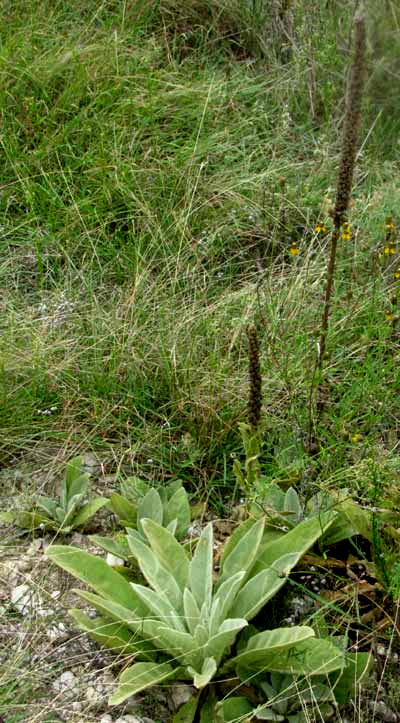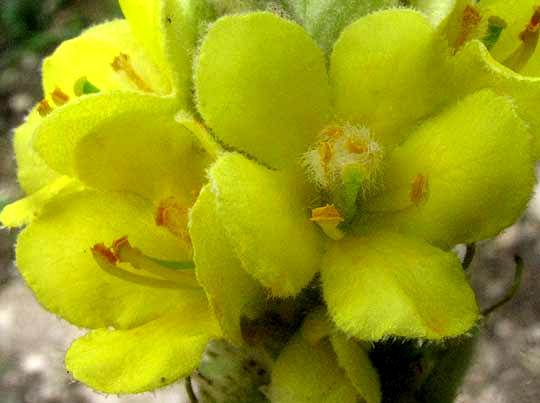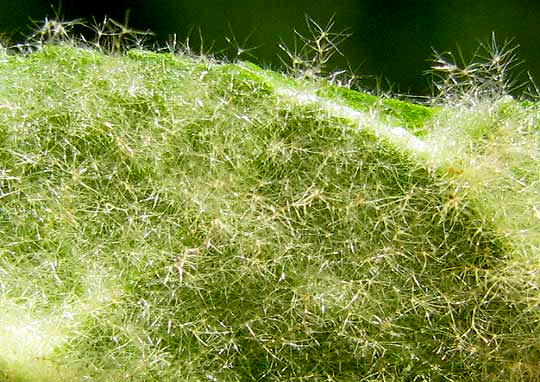Excerpts from Jim Conrad's
Naturalist Newsletter

from the the September 9, 2012 Newsletter issued from the valley of the Dry Frio River in northern Uvalde County, southwestern Texas, on the southern border of the Edwards Plateau; elevation ~1750m (~5750 ft); N29.62°, W99.86°; USA
MULLEIN
A fairly common weed along roads and in miscellaneous abused soils nowadays is the one flowering above.
As a kid this was one of the first two or three plants I learned the name of from a book, because it was so distinctive with its rosette of large, soft-fuzzy leaves topped with a spike of yellow blossoms that even with the simple black-ink drawings in my old wildflower book I could be sure of what I was seeing. There's just nothing else that looks like it. Common Mullein, the book said, VERBASCUM THAPSUS. "The ancient Romans dipped Mullein stem heads in tallow, set them ablaze, and used them as torches in funeral processions," I read. To this day I can't see a Mullein without visualizing weeping Romans in white togas bearing a casket through dark streets.
I'm used to Mullein flowering earlier in the year, in June or so, so maybe our flowering ones are reacting to an unusual downpour occurring here a few weeks back. Other Mulleins in the area already have their tall, dark spikes of seed-dropping capsules, as shown below:

That picture shows something important about Mulleins. That is, Mulleins are biennials. During their first year of growth they produce only rosettes of leaves, like the plants in the front of the picture. Then in the second year the flowering spike "bolts" higher and faster than any mere annual plant could manage, taking advantage of energy in carbohydrate stored during its first year of life. This is an important adaptation, since the species doesn't compete well with other plants, being intolerant of shade and disturbances such as tilling. Another adaptation compensating for these deficiencies is that the seeds remain viable for decades -- even a hundred years or so according to some studies -- so they can wait in the soil until conditions are just right for them. They germinate only on bare soil, or after a fire.
Mullein's flowers bear five lobes, or petals, and are slightly asymmetrical -- they're bilaterally symmetrical instead of radially symmetrical. A flower close-up shows this, as well as the five stamens -- three smaller, very hairy upper ones and two larger, hairless ones below -- below:

Mullein is native to Europe, northern Africa and Asia, but was introduced here early. The Puritans brought mullein seeds to America for their medicinal herb gardens. From ancient times in Europe a tea was made from its leaves as a cure for lung diseases in both humans and livestock. It's been used against diarrhea and rheumatism, and ointments have been made of it for burns and earaches. Sometimes its dried leaves have been smoked as a tobacco substitute.
With such a long, colorful history, the plant has acquired many names other than Mullein. There's Hedge-taper, Candlewick, Lungwort, Feltwort, Hare's-beard, Torches, Blanketleaf; Jacob's-, Jupiter's-, and Peter's-staff, Shepherd's Club, Aaron's Rod, Velvetplant, Old Man's Flannel, Miner's Candle, and others.
The names referring to felt, blankets and velvet comment on the pleasantly soft and fuzzy felt covering the leaves. A close-up showing how the long hairs branch and mat together is below:
